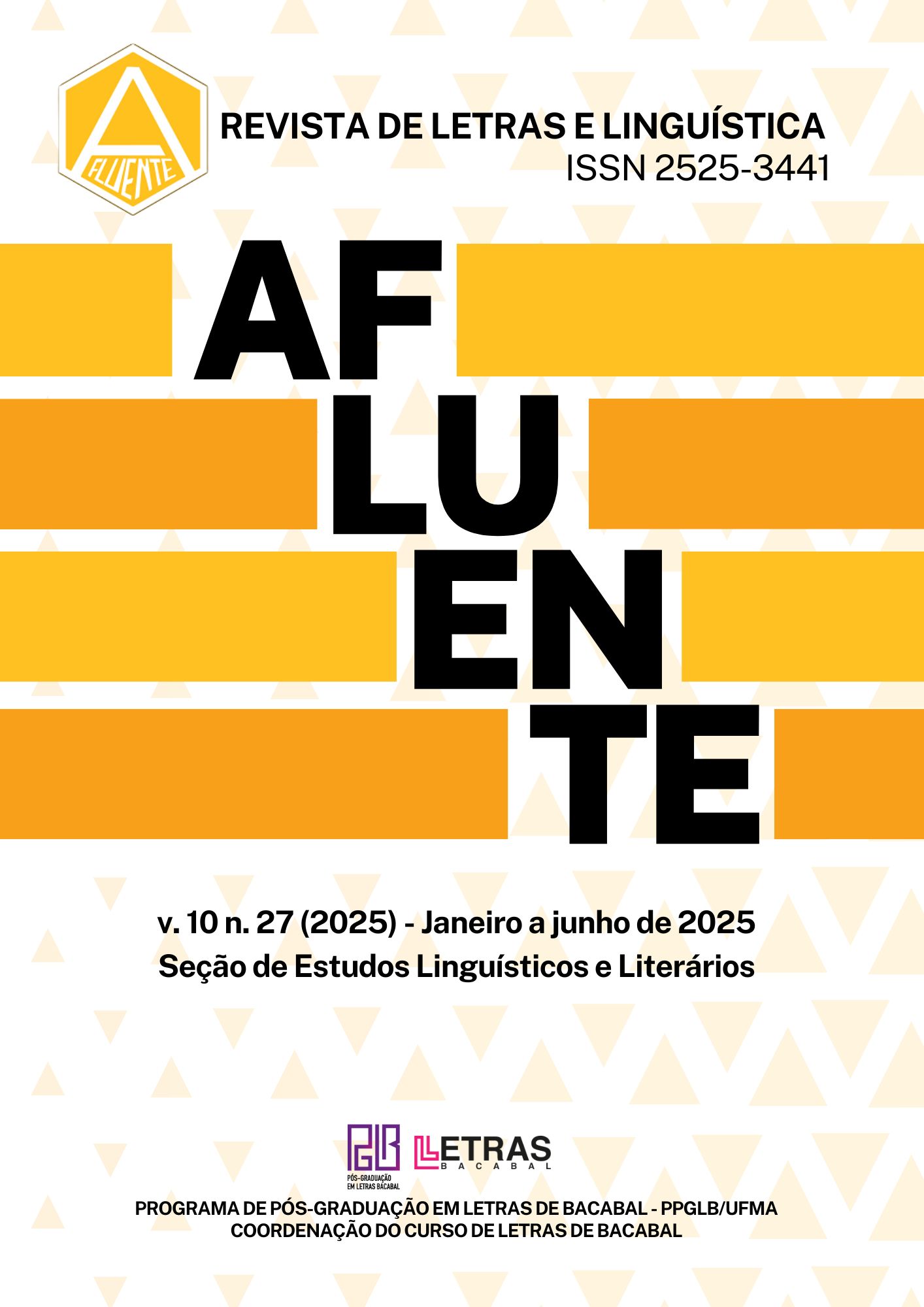Língua, cultura e identidade: fronteiras entre línguas nos dizeres de um imigrante
DOI:
https://doi.org/10.18764/2525-3441v10n27.2025.05Palavras-chave:
Heterogeneidade enunciativa, Imigração japonesa, Identidade nipo-brasileiraResumo
Este trabalho analisa como a língua japonesa emerge em interações verbais orais em português brasileiro de um sujeito imigrante japonês, tomando como corpus o documentário As Lentes de Kenji (2008), que homenageia o fotógrafo Kenji Ueta, imigrante japonês radicado em Maringá. Com base na teoria das heterogeneidades enunciativas, de Authier-Revuz (1990; 1998; 2004; 2007), investigamos como o sujeito mobiliza a língua japonesa (e, consequentemente, a cultura japonesa) em sua enunciação, buscando compreender como o sujeito transita entre fronteiras linguísticas e culturais na sua construção enquanto sujeito imigrante e na sua circulação por identidades – no sentido de Hall (2006). Para tanto, foram selecionados e transcritos, de acordo com as normas do NURC descritas por Castilho (2014), momentos em que o sujeito é flagrado transitando entre línguas. Foi realizada uma análise qualitativa desses momentos, a fim de descrever os usos do japonês no dizer do sujeito e compreender os pontos de heterogeneidade mostrada que emergem em sua fala. Os resultados indicam que essas emergências se configuram como marcas discursivas que mostram um sujeito cindido entre línguas e culturas e pela dupla nacionalidade nipo-brasileira. Assim, ao recorrer ao japonês para expressar suas experiências e práticas, o sujeito reafirma suas identidades nipo-brasileira, articulando-se discursivamente entre duas tradições linguísticas e culturais.
Downloads
Referências
AUTHIER-REVUZ, J. Entre a transparência e a opacidade: um estudo enunciativo do sentido. Porto Alegre: EDIPUCRS, 2004.
AUTHIER-REVUZ, J. Heterogeneidade(s) enunciativa(s). Cadernos de estudos linguísticos, v. 19, p. 25-42, 1990.
AUTHIER-REVUZ, J. Nos riscos da alusão. In: Revista Investigações. Pernambuco, v. 20, n. 02, 2007. Disponível em: https://periodicos.ufpe.br/revistas/INV/article/view/1468. AUTHIER-REVUZ, J. Palavras incertas: as não-coincidências do dizer. Campinas/SP: Unicamp, 1998.
BARBOSA, J. C. M. Reassentamentos urbanos de imigrados palestinos no Brasil: um estudo de caso do “campo” de Brasília. 2010, 142 f. Dissertação (Mestrado em Sociologia e Política) – Departamento de Sociologia e Política, Pontifícia Universidade Católica, Rio de Janeiro, 2010.
BENITES, S. A. L. Fonologia. In: BENITES, S. A. L.; ANTONIO, J. D. (Org.). Fonética e Fonologia. Maringá: EDUEM, 2011, p. 33-50.
BOURDIEU, P. Um analista do inconsciente. In: SAYAD, A. A imigração ou os Paradoxos da Alteridade. São Paulo: Editora da Universidade de São Paulo, p. 09-12, 1998.
BRANDÃO, H. N. Introdução à análise do discurso. 3.ed. Campinas: Editora da UNICAMP, 2012. 117 p.
CÂMARA Jr, J. M. Estrutura da Língua Portuguesa. 30 ed. Petrópolis, RJ: Vozes, 1999.
CASTILHO, A. T. Nova gramática do português brasileiro. 1 ed., 3ª reimpressão. São Paulo: Contexto, 2014. CAZELATO, S. E. O. A cristalização dos provérbios e sua vigência nas práticas de gêneros textuais ou práticas comunicativas. Sínteses, v. 14, p. 86-104, 2009.
CORACINI, M. J. R. F. A celebração do outro: arquivo, memória e identidade – línguas (materna e estrangeira), plurilinguismo e tradução. Campinas: Mercado de Letras, 2007.
DAI PRÁ, G. A. L. ; MAGALHÃES, M. L.; SCHEMES, C.. Undokai e Shinnenkai: manifestações culturais japonesas em uma localidade germânica (Ivoti/RS). Humanidades & Inovação, v. 9, n. 24, p. 208-221, 2022.
DOI, E. T. . O ritmo bimoraico e as Moras não-plenas do japonês: reflexões sobre o ensino da língua oral. Trabalho em Lingüística Aplicada, Campinas, v. 36, p. 51-60, 2000.
HALL, S. A identidade cultural na pós-modernidade. 11ª ed. Rio de Janeiro: DP&A, 2006.
HATUGAI, E. R. Parentesco, conflito e identificações entre famílias internéticas de descendentes de japoneses e não-descendentes. Comunicação. I Seminário Internacional de Pós-Graduação em Ciências Sociais. Marília, UNESP, 2015.
LESSER, J. A negociação da identidade nacional: imigrantes, minorias e a luta pela etnicidade no Brasil. São Paulo: Editora UNESP, 2001.
NOMURA, G. M. . Processos de ressilabação do português por aprendizes japoneses. In: AMADO, R. S. ; GIL, B.D. (Org.). Reflexões sobre o ensino de português para falantes de outras línguas. 1ed.São Paulo: Paulistana, 2012, v. , p. 68-73.
OBERST, L.C. A escrita da criança entre línguas. 2019. 147 f. Dissertação (Mestrado em Letras) – Programa de Pós-Graduação em Letras, Universidade Estadual de Maringá, Maringá, 2019.
OHATA, K. Phonological differences between Japanese and English: several potentially problematic areas of pronunciation for Japanese ESL/EFL learners. Asian EFL Journal, Hong Kong, v. 6, n. 4, 2004.
SATO, A. de J. Undokai: a construção de identidade étnico-cultural em torno da niponicidade. In: Anais do XXVI Simpósio Nacional de História – ANPUH. São Paulo, jul. 2011. Disponível em: http://www.snh2011.anpuh.org/resources/anais/14/1308075108_ARQUIVO_ANPUH-USP.pdf. Acesso em: 11 out. 2024.
SUMAIRU rain (Emi-sen) no imi to tokuchō. Minna Shigaku. Disponível em: <https://minna-shigaku.com/category26/entry585.html>. Acesso em: 02 de ago. de 2024.
TOMAZI, N. D. Construções e silêncios sobre a (re)ocupação da região norte do estado do Paraná. In: DIAS, Reginaldo Benedito; GONÇALVES, José Henrique Rollo. (Orgs.). Maringá e o Norte do Paraná: estudos de História Regional. Maringá: EDUEM, 1999. pp. 51 – 86.
TVClipping Maringá-Paraná. Documentário "As Lentes de Kenji" - Diretor: Antonio Roberto de Paula. YouTube, 19 de fev. de 2013. Disponível em: https://www.youtube.com/watch?v=hgR0ZE09rH4.
ZANARDO, L; VALENTE, M. L. L. C. Família e gênero na contemporaneidade. Revista de Psicologia da UNESP, v. 8, n. 2, p. 5-5, 2009.
Downloads
Publicado
Como Citar
Edição
Seção
Licença
Copyright (c) 2025 Afluente: Revista de Letras e Linguística

Este trabalho está licenciado sob uma licença Creative Commons Attribution 4.0 International License.
Direitos autorais Afluente: Revista Eletrônica de Letras e Linguística
Este trabalho está licenciado com uma Licença Creative Commons - Atribuição 4.0 Internacional.














